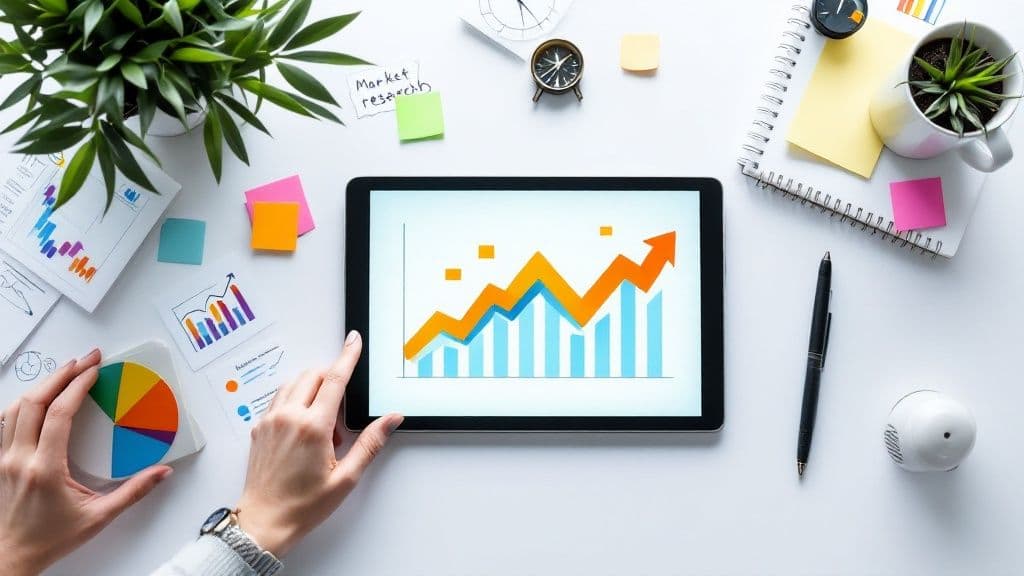Business forecasting helps you predict sales, demand, and cash flow so you can plan with confidence. This guide explains practical qualitative and quantitative techniques, when to use each approach, and which tools turn forecasts into profitable actions.
September 25, 2025 (1mo ago) — last updated October 26, 2025 (27d ago)
Sales and Cash Flow Forecasting Guide
Combine qualitative and quantitative forecasting to predict sales, manage cash flow, and make data-driven decisions with practical tools.
← Back to blog
Sales and Cash Flow Forecasting Guide

Business forecasting helps you predict sales, demand, and cash flow so you can plan with confidence. This guide explains practical qualitative and quantitative techniques, when to use each approach, and which tools turn forecasts into profitable actions.
Why forecasting matters
Forecasting moves a business from reactive to proactive. Good forecasts help you:
- Avoid stockouts and reduce excess inventory1
- Plan staffing and operations more efficiently
- Protect cash flow and reduce financing costs
- Prioritize investments that improve valuation
Forecasting isn’t a crystal ball. It’s a structured way to combine evidence and experience so you can plan with confidence.
Quick guide: when to use which method
- If you have clean historical data (2+ years), prioritize quantitative methods such as time-series analysis or regression.
- If you’re launching a new product, entering a new market, or data is limited, use qualitative methods like market research or the Delphi method.
- Often the best approach is hybrid forecasting: build a data-driven baseline, then adjust with expert input.
Qualitative forecasting: the art of judgment
Qualitative methods are essential when historical data is sparse or irrelevant. They rely on human insight and structured research.
Expert panels and opinion
Gather diverse expert views — sales leaders, product managers, industry consultants — and synthesize them. Panel input is fast and effective for near-term tactical decisions or when market dynamics shift quickly.
Market research
Surveys, interviews, and focus groups reveal customer intent and preferences. For new products, direct customer feedback often beats historical analogies.
The Delphi method
The Delphi method uses multiple anonymous rounds of expert input and feedback to converge on a consensus forecast. It reduces bias and is useful for long-term or complex market questions.
Tip: translate qualitative estimates into financial scenarios using the Email List Value Estimator to forecast marketing revenue from a captured segment.
Quantitative forecasting: the science of data
When you have reliable historical data, quantitative methods give objective, repeatable forecasts.
Moving averages and percent-of-sales
Moving averages smooth noise and reveal short-term trends — great for demand planning. The percent-of-sales method projects related financial line items (COGS, marketing) as a stable share of revenue, which is useful for simple financial projections.
Time-series analysis
Time-series models decompose data into trend, seasonality, cycles, and irregular components. These models are powerful for businesses with predictable seasonality, such as retail holiday spikes. For a deeper tutorial, see the time-series guide at Time-series analysis deep dive.3
Regression analysis
Regression measures relationships — for example, how changes in ad spend, price, or traffic affect sales. Knowing these elasticities helps you forecast the impact of planned actions and optimize marketing ROI.
If you’re modeling how strategy changes affect company value, use the Business Valuation Estimator to map revenue and margin shifts to valuation outcomes.
Tools that make forecasting practical
You don’t need a data-science team to use modern forecasting tools. The right toolset turns forecasts into actionable scenarios:
- Email List Value Estimator for marketing revenue forecasts
- Business Valuation Estimator to see how forecasted growth affects valuation
- Energy Utility Bill Forecaster to model operational costs like utilities
- Instagram Account Value Estimator to estimate social media returns and inform campaign planning
These tools help you run “what-if” scenarios and connect forecasts directly to profit and cash outcomes.
Choosing the right method: a short checklist
- Assess your data: do you have 2+ years of clean data? If yes, favor quantitative methods.
- Define the horizon: short-term (days or weeks) versus long-term (months or years) changes the method.
- Determine required accuracy: what’s the cost of a 10% error?
- Use hybrid approaches: blend data-driven baselines with expert adjustments.
- Update regularly: use rolling forecasts so plans stay aligned with reality2.
Practical tips to get started
- Start simple: use moving averages to learn your data’s rhythm. For a template, see Moving average template and tutorial.
- Build a baseline, then layer in expert adjustments for known events like new competitors or product launches.
- Automate data collection where possible — clean inputs make better forecasts.
- Review forecasts on a cadence that suits your business volatility (daily for retail, monthly for B2B).
Common FAQs
How accurate does my forecast need to be?
It depends on the cost of being wrong. For high-cost decisions, such as large raw-material orders, invest in more accurate quantitative models. For directional internal planning, a simpler approach usually suffices.
Can I mix methods?
Yes. Hybrid forecasting often yields the best results: quantitative baselines plus qualitative adjustments for one-off events.
How often should I update forecasts?
Treat forecasts as living documents. Use a rolling forecast and update as new information arrives — weekly for fast-moving businesses, monthly or quarterly for slower ones.
What if I don’t have a data scientist?
Start with simple tools and calculators, and scale complexity as you learn. Many online tools make advanced models accessible without deep technical skills.
Internal links to expand learning
- Time-series analysis deep dive: Time-series analysis deep dive
- Cash flow forecasting walkthrough: Cash flow forecasting walkthrough
- Moving average template and tutorial: Moving average template and tutorial
- Tools index and product pages: Tools index
Key takeaways
- Use the data you have: quantitative methods for rich datasets, qualitative when data is limited.
- Combine science and judgment; hybrid forecasts are more robust.
- Link forecasts to financial outcomes using scenario tools to prioritize actions that boost profitability and valuation.
Ready to turn forecasting into a repeatable advantage? Try the tools linked above to model demand, costs, and valuation scenarios and make better decisions today.
Quick Q&A
Which forecasting method should I start with?
If you have 2+ years of clean sales data, start with a simple time-series model or moving average. If data is limited, begin with structured qualitative methods and convert those estimates into financial scenarios.
How often should I update forecasts for a retail business?
Update weekly or use daily rolling forecasts for fast-moving retail categories. Slower categories can be reviewed monthly.
How do I link forecasts to cash flow and valuation?
Build a revenue baseline, project related expenses as percent-of-sales, and run scenarios through a valuation tool such as the Business Valuation Estimator.
Ready to Build Your Own Tools for Free?
Join hundreds of businesses already using custom estimation tools to increase profits and win more clients